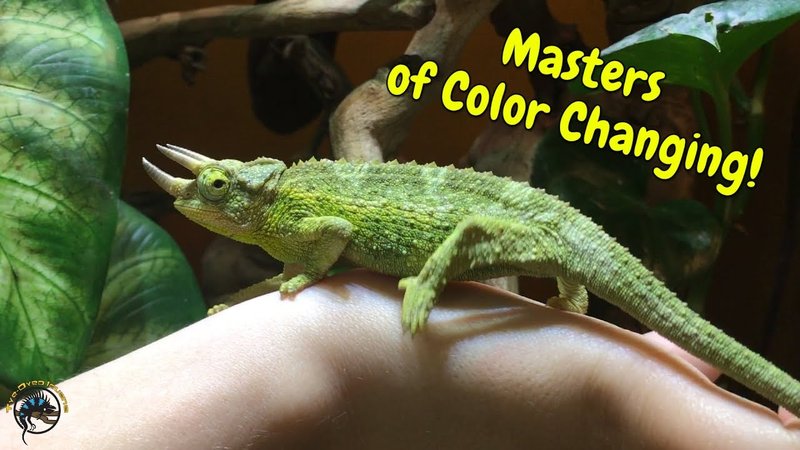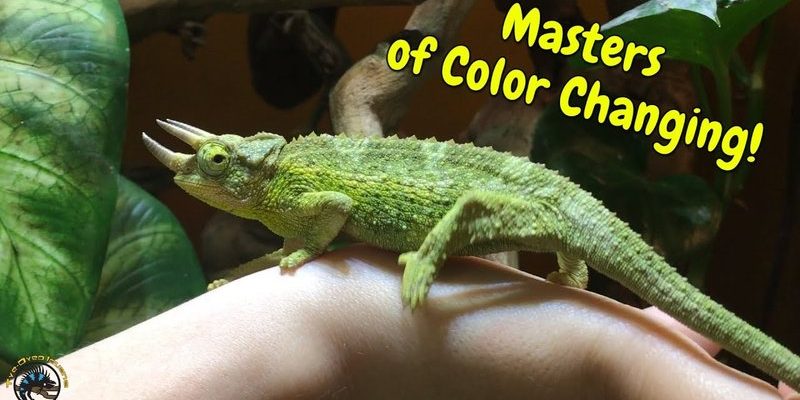
Honestly, understanding how the Jackson’s chameleon changes colors can feel like peeling an onion—there are multiple layers to uncover. While they do have the ability to change colors, the reasons and mechanisms behind this ability are often misunderstood. So, sit back as we keep things simple and clear, revealing the reality behind these enchanting reptiles.
What Makes Jackson’s Chameleons Unique?
Before we delve into color-changing abilities, let’s take a moment to appreciate what makes the Jackson’s chameleon special. Native to the cloud forests of East Africa, they’re distinct not just for their color but also for their unique physical traits.
Firstly, the Jackson’s chameleon has three horn-like projections on its head, giving it a bit of an otherworldly appearance. They sport a mix of bright greens, blues, and yellows, making them look like walking pieces of art in nature. But it’s not all about looks—these creatures have fascinating behaviors that help them survive.
What you might find interesting is that their color can actually signal different moods. Think of it like a visual language. When they’re feeling threatened, they might go darker; when they’re relaxed or basking in the sun, they can brighten up. So, color change isn’t just for show; it serves a purpose in their communication and survival.
How Do Chameleons Change Colors? The Science Explained
You might be wondering how exactly these little guys pull off their color transformations. The secret lies beneath their skin, in a layered structure of cells. Let me break it down for you:
– Chromatophores: These are pigment-containing cells that lie in the top layer of the skin. Think of them as tiny paint pots that can show different colors based on their contents.
– Iridophores: Below the chromatophores, these cells contain guanine crystals that reflect light. They don’t have color themselves but can manipulate light to create different effects. It’s like adding a filter to a photo!
– Melanophores: These deeper skin cells contain dark pigments and can help tone down brighter colors or darken the overall appearance of the chameleon.
When a Jackson’s chameleon wants to change color, it essentially expands or contracts these layers of cells. So, while it sounds magical, there’s a solid scientific process happening right under the skin that creates those stunning color shifts.
Can Jackson’s Chameleons Change Colors on Command?
Here’s the thing: While Jackson’s chameleons can change colors, it doesn’t work like flipping a switch. Many people think they can just change colors whenever they want, much like opening a box of crayons. In reality, their color changes are usually a response to environmental factors or emotional states.
For instance, when feeling stressed or threatened, a chameleon may darken its color as a defense mechanism. On the other hand, during mating displays, a male might brighten up to attract a female. So, instead of having full control over their colors like a shape-shifter, they respond to their surroundings and feelings, much like we do when we’re in different moods.
Common Myths About Color Change
There’s a lot of chatter out there about chameleons and their color-changing abilities. Let’s separate some facts from fiction to clear the air.
- Myth 1: They change color to blend in with their environment. Fact: While they can adjust their hue somewhat, they primarily change color due to mood, not as a camouflage tactic like many think.
- Myth 2: Every chameleon can change color dramatically. Fact: Different species have varying abilities; the Jackson’s chameleon has a limited range compared to others.
- Myth 3: Color change is a sign of health. Fact: Stress or illness can also cause color changes, so it’s not always a positive sign.
Understanding these myths helps paint a clearer picture of what’s really going on with these captivating creatures.
What Impacts Their Color Change?
Several factors influence how and when a Jackson’s chameleon changes color. Let’s explore some of them:
1. Temperature: Just like us, chameleons can react to temperature changes. When it’s warm, they might display brighter colors to absorb heat, while cooler temps can lead to darker shades.
2. Lighting: Natural sunlight plays a huge role. Under bright light, colors can become more vibrant. Think about how you look in different lighting—it’s similar for them!
3. Social Interactions: When competing for mates or asserting dominance, males may become more colorful and pronounced in their displays. It’s like putting on a fancy outfit for a big night out.
By recognizing these factors, you can gain a deeper appreciation for the complexity of these little creatures. Their color-changing ability goes beyond simple aesthetics; it’s a dynamic part of their biology and behavior.
In summary, the color-changing ability of the Jackson’s chameleon is a fascinating blend of biology and behavior. While they can indeed change colors, it’s not a superpower they wield at will. Instead, their hues reflect their emotions, temperature, and social interactions, similar to how we might dress according to our mood or the occasion.
So, the next time you hear someone say that chameleons can change color like magic, you can confidently share the real story. It’s a beautiful example of how nature works, full of surprises and complexity. Understanding these creatures helps us appreciate them even more, allowing us to see the colors of their world—not just the bright greens and blues, but the deeper meanings behind those vibrant shades.

